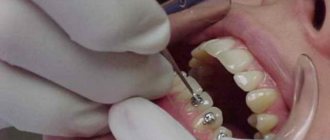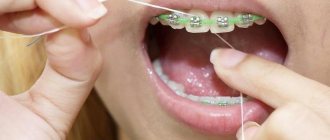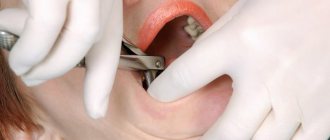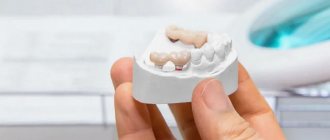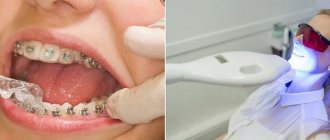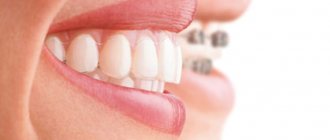If you need to make room before installing orthodontic Invisalign aligners, braces or dentures so that each tooth is in the correct position, separation (interproximal enamel reduction) is performed. The operation is painless, bloodless, minimally traumatic, does not require long-term rehabilitation, but can lead to complications if performed incorrectly on the patient.
What is teeth separation: which doctor does it?
Separation is a technique for expanding the interdental space, during which a thin layer of enamel (no more than 0.25 mm) is removed from the sides of the incisors, thereby freeing up space. Sawing is carried out using a drill, strips, and sometimes a special file is used. Carefully remove the protruding part where the two teeth meet. The procedure is a worthy alternative to extirpation, it allows you to keep your teeth healthy and functional, and
avoids the removal of molars (6, 7 and 8) and other dental units.
Separation of enamel is safe for teeth and does not provoke their hypersensitivity.
Preparing for surgery
Before separating the dentition, the doctor takes a panoramic photograph of the oral cavity. It allows you to assess the current condition of the latter and identify the presence of hidden pathologies. If necessary, a teleradiogram is additionally prescribed. Next, the doctor makes an impression of the problem area and calculates the course of the future procedure.
In some cases, consultation with a psychologist and osteopath is indicated. These specialists are usually contacted when separation is carried out before installing braces. Such systems create temporary discomfort and worsen the patient’s appearance.
What are the types
There are two ways to carry out separation:
- Mechanical - using a drill with diamond discs, strips or files, a thin layer of enamel (less than 1 mm) is removed from the side surfaces of the incisors.
- Physiological - the interdental spaces expand naturally with the help of wedges, elastic bands, and threads that are inserted into them.
Both methods are practical, but the first method provides instant results. In the second case, you will have to wait several days, so mechanical separation is used more often than physiological separation.
Forecast
When going to the dentist’s office, the patient hopes for comfortable and high-quality treatment, the doctor’s understanding and the desire to make every effort to restore and preserve the client’s teeth.
Separation is not yet a widely accepted tooth-preserving method for correcting defects of the maxillofacial region. However, when there is a shortage of space for adjacent units, this is the most effective way to obtain it.
For information on the separation of interdental spaces, watch the video.
Advantages
The main advantage of the procedure is the ability to preserve healthy teeth. Additional benefits:
- painlessly and quickly frees up space for orthodontic therapy (correction of crowding or malocclusion, jaw prosthetics);
- no long recovery required;
- soft gum tissue is not damaged;
- there is no need for additional treatment of gums (only in the absence of complications);
- the integrity and sensitivity of the teeth is not impaired;
- The operation is performed in one session lasting up to 40 minutes.
Interproximal enamel reduction is only safe when performed by a qualified, experienced dentist. Therefore, you need to carefully choose a clinic and specialist.
How much money do you need
Not a single decent clinic will calculate the cost of treatment for a patient over the phone. The total cost to a patient depends on many factors:
- scope of diagnostics;
- need for x-rays;
- the scope of the work itself;
- application of anesthesia and other services.
The region of residence of the patient and the qualifications of the doctor are important.
If you decide to take care of your loved one, look for a clinic in your city, choose a doctor who inspires your trust, and start working on improving your appearance. And then - there is no limit to perfection!
Who is indicated for the procedure?
Enamel separation is prescribed in cases where the teeth are healthy and there is no indication for their removal, but the row is too dense, which makes it impossible to carry out orthodontic treatment to correct the bite. Main indications:
- the width of the upper incisors does not correspond to the width of the lower ones;
- protrusion of the upper and lower frontal incisors;
- removal is contraindicated if the bite is misaligned;
- asymmetry or inclination of the teeth of the upper and lower rows;
- correction of triangular teeth, due to the shape of which, after correcting the bite, black small triangles remain between the incisors.
It makes sense to carry out separation before and during wearing orthodontic structures (braces, plates). Mandatory before prosthetics (installation of a crown, bridge), will help with tooth retention (growth retardation). The main goal of the procedure is to correct the shape/size of the tooth and at the same time increase the free space for it to move into the correct position.
Recommendations for aesthetics
The center's hygienist recommends that the patient undergo a month-long course of therapy aimed at remineralizing the enamel. For this, two modern preparations are offered: Tuss Mousse cream or Rocs Medical Minerals gel to choose from. The goal of therapy is to strengthen tooth enamel, even out the color of teeth, and minimize white spots on teeth.
The aesthetic dentist of the center offers a more radical solution that will cope with all problems at once - ceramic veneers. The doctor also drew the patient’s attention to a change in the color of the front right incisor - it is necessary to take an X-ray of the tooth to exclude inflammation in the tooth canals and carry out treatment of the tooth canals and internal tooth whitening. Over time and without proper treatment, the darkening of the tooth may worsen, and the dark tooth will become visible through the veneers.
The patient is currently undergoing remineralization therapy with a hygienist and in the near future plans to continue treatment with an aesthetic dentist to create an ideal smile.
See other examples of bite correction from Dial-Dent specialists here.
Make an appointment for a consultation by phone +7-499-110-18-01 or through the form on the website. You can ask questions about correcting your bite to the chief doctor of the clinic, Sergei Vladimirovich Tsukor, at
Contraindications
Any dental procedures have contraindications. Separation is not carried out when:
- caries;
- pulpitis;
- periodontal inflammation;
- excessive bleeding and sensitivity of the gums.
Also, any infectious diseases of the oral cavity are contraindications to interproximal enamel reduction. Carrying out surgery in the presence of contraindications threatens the spread of infection to healthy teeth and tissues in the oral cavity.
Why restore your bite?
A direct connection has been established between the condition of the oral cavity and the functioning of the gastrointestinal tract. Due to malocclusion, a person does not chew food enough. And large pieces of food penetrate into the gastrointestinal tract, provoking the development of various pathologies.
Why can our articles be trusted?
We make health information clear, accessible and relevant.
- All articles are checked by practicing doctors.
- We take scientific literature and the latest research as a basis.
- We publish detailed articles that answer all questions.
In addition, malocclusion often causes the development of dental diseases. For example, due to a violation of the structure of the dentition, the mucous membrane is often subjected to mechanical stress. Microcracks regularly form on its surface, through which pathogenic microflora penetrate. The active development of bacteria leads to the appearance of foci of inflammation.
In advanced cases, malocclusion becomes the cause of the development of sinusitis, which, when complicated, provokes the appearance of meningitis and other equally dangerous pathologies. Some of these diseases lead to death.
Bite restoration is a necessary procedure to prevent the development of many diseases.
What and how it is performed on the front upper and lower incisors
Mechanical separation on incisors is performed in one visit to the dentist:
- Using a saw and a drill with a diamond disc (special tip), the side sections of the enamel are removed in an even layer. To prevent injury, the mirror pushes back soft tissue. The file is used less frequently than the vertical attachment of drills, but provides higher accuracy.
- Sawed surfaces are ground and polished. Sanding smoothes out unevenness.
- To protect teeth from hyperesthesia, a strengthening composition is applied to the enamel.
Immediately after the operation, you can see the result - an increase in the space between the incisors. Physiological separation differs in many ways from mechanical separation and takes longer:
- Wedges are inserted into the interdental spaces or they are stretched with rubber bands.
- The patient is sent home for a certain time.
- The wedges are removed and further therapeutic manipulations are carried out.
After the procedure, if it is necessary to correct the bite, an elastic chain is placed on the dentition to close the gaps. They are tightened due to the alignment of the bite over one to four months.
Results of orthodontic treatment
Thanks to modern diagnostic and treatment methods, it has become possible to eliminate protrusion and straighten teeth without removing teeth. The facial profile has become more harmonious.
| Profile before treatment | Profile after treatment |
The duration of treatment was 14 months, the cost was 170,800 rubles.
When is it recommended?
Patients are offered the procedure in situations where an effective course depends on timely changes in the size or shape of the crown, as well as on the availability of free space within the dentition.
Separation is most often recommended in the following cases:
- before installing dentures on crowns;
- before installing bridges;
- when restoring bite with braces;
- in the treatment of retention.
Treatment with braces may be accompanied by separation if it is necessary to eliminate crowding in the frontal or lateral area of the upper or lower jaw. The same technique allows you to equalize the width of antagonist teeth if it is very different from the rest of the elements of the dentition. After grinding, closure in the anterior and lateral zones is normalized. Sometimes the removal of a layer of enamel is aimed at adding aesthetics to the smile area, for example, when crowns are unevenly narrowed or widened at the top or bottom.
Separation does not always help: if the lack of space is too great, then grinding is not enough; only removal will help. But in cases where the lack of space is less than 0.8 mm, and removal would free up too much space, separation becomes the ideal solution to the problem.
Safety and Consequences
Patients often refuse separation when wearing braces, fearing that this operation can significantly damage the enamel and cause dental problems. You should know that this technique has been used for almost 60 years, and this has made it possible to study its consequences in detail. Removing a thin layer does not increase the likelihood of caries, since the appearance of carious lesions is caused by the activity of acid-forming bacteria. The enamel layer does not in any way affect the life activity of these organisms. The main point is impeccable hygiene. Therefore, people who neglect oral care often develop caries, even if they have never undergone separation.
The only unpleasant consequence of grinding may be increased sensitivity, but this easily goes away in the first week or two, especially if you use toothpaste for sensitive teeth.
Possible complications
Errors made by a doctor during the process of teeth separation lead to:
- damage to the pulp, which can cause tissue death;
- increasing the sensitivity of treated teeth;
- inflammation of the gum tissue.
These consequences arise only due to the low qualifications of the attending physician. Moreover, the patient himself is able to identify shortcomings in the work of a specialist. To do this, you need to pay attention to how the doctor holds the tip of the drill machine: his hand should be fixed on the patient’s chin.
Will it hurt?
This question is asked by many patients. But there is no need to worry, since you will not experience any pain. Before the procedure, the doctor will apply a local “freeze” or may administer anesthesia. However, if a specialist uses a boron during the grinding process, this can cause unpleasant sensations, because the sound of the device, as well as the vibrations it produces, frighten and irritate many.
The fact that teeth separation is painless is confirmed by patient reviews.
“I had teeth separated with braces. Before installing braces, the doctor sawed off part of the enamel. It was unpleasant, but there was definitely no pain. But after the procedure, already at home, the first 2-3 days were uncomfortable when I ate cold and hot food. But in general, this is definitely much better than deleting. During and after removal, the sensations are much more disgusting, and the risk of complications is higher. Plus, don’t forget about the moral factor, because all the teeth are preserved during separation, and this gives peace of mind!”
Kalinkina Svetlana, review from gidpozubam.ru
“Before the procedure, I was given an injection of painkillers, so I didn’t feel anything during the process. The only thing that bothered me was the noise and buzzing of the drill - it constantly made me shudder.”
N. Olya, fragment of a review from the site otzovik.com
Deadlines
The separation plan depends on the specific clinical picture and the functions that this procedure provides. Sometimes it is carried out immediately before installing braces, but in some cases the orthodontist recommends first installing the system, and after four to six months (after the appearance of a visible effect and assessing the speed of the processes), grinding is carried out. There is no need to remove braces for this; simply remove the arch for the duration of the manipulation, which takes 15-20 minutes.

